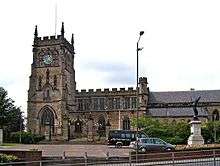St Mary and All Saints' Church, Kidderminster
| St Mary and All Saints’ Parish Church, Kidderminster | |
|---|---|
 St Mary and All Saints’ Parish Church, Kidderminster | |
| Coordinates: 52°23′25.11″N 2°15′2.83″W / 52.3903083°N 2.2507861°W | |
| Location | Kidderminster |
| Country | England |
| Denomination | Church of England |
| Website | www.kpctm.co.uk/st-marys-kidderminster |
| History | |
| Dedication | St Mary All Saints' |
| Specifications | |
| Length | 215 feet (66 m) |
| Administration | |
| Parish | Kidderminster |
| Deanery | Kidderminster |
| Archdeaconry | Dudley |
| Diocese | Diocese of Worcester |
St Mary and All Saints’ Church, Kidderminster is a Grade I listed parish church in the Church of England in Kidderminster, Worcestershire, England.[1]
History
The foundation existed at the time of the Domesday book. Records of a consecration in 1315 probably refer to the chancel. The current church building dates mostly from the 15th and 16th centuries.
in April 1641, during the English Civil War, the vicar George Dance, agreed that he would give £60 a year, out of his income of £200, to a preacher who should be chosen by certain trustees. Richard Baxter was invited to deliver a sermon before the people, and was unanimously elected as the minister, or lecturer, of St Mary and All Saints' Church, Kidderminster.[2]
In 1847 a south aisle was added the chancel by Harvey Eginton, and the organ chamber was added in 1874. The tower was refaced in 1893 – 1895 by J.A. Chatwin.
The Whittall Chapel was added in 1921-1922 by Giles Gilbert Scott. Hubert Clist undertook some work in 1966 – 1967. Ronald Sims re-ordered the interior in 1988 – 1990.
Organ
There are records of organ in the church dating from 1848 when an instrument was installed by George Holdich. There have been subsequent rebuildings and renovations over the years, resulting in a 3-manual and pedal pipe organ. The organ case was added in 1927 – 1928 by Giles Gilbert Scott. A specification of the organ can be found on the National Pipe Organ Register.[3]
A separate pipe organ is situated in the Whitall Memorial Chapel. A specification of the organ can be found on the National Pipe Organ Register.[4]
References
- ↑ The buildings of England. Worcestershire, Nikolaus Pevsner
- ↑ Chisholm 1911, p. 551.
- ↑ http://www.npor.org.uk/cgi-bin/Rsearch.cgi?Fn=Rsearch&rec_index=D06116
- ↑ http://www.npor.org.uk/cgi-bin/Rsearch.cgi?Fn=Rsearch&rec_index=N03734